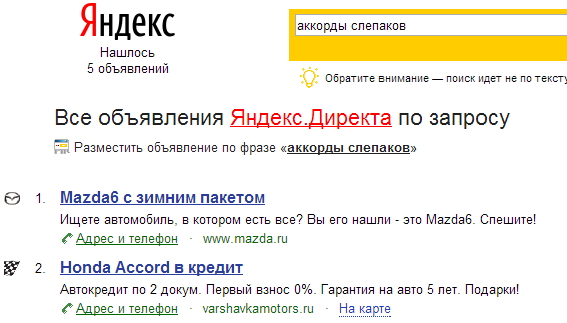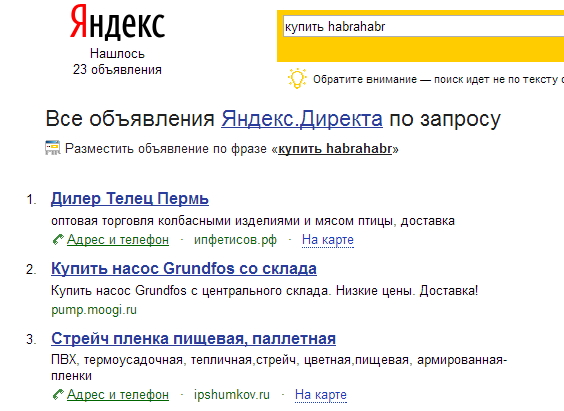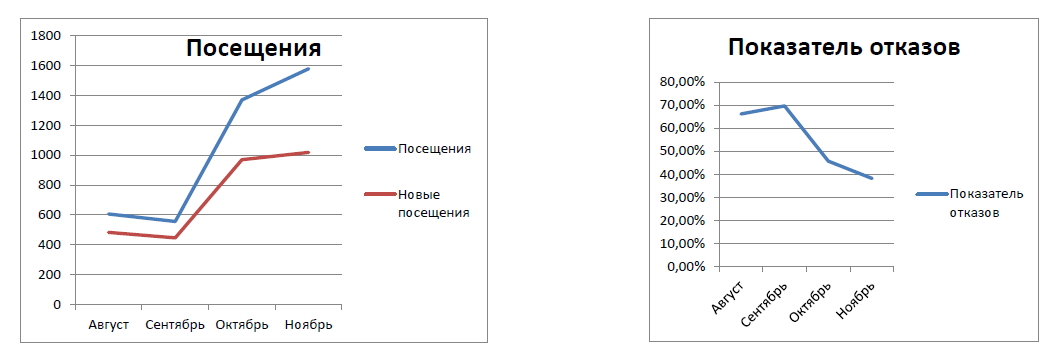How not to be disappointed in the context. 10 pitfalls and one real project

When a person who is not previously familiar with contextual advertising, decides to place a couple of ads, his heart warms the idea that the context is very effective. Still, you only need to pay for transitions, all indicators are recorded and it is very easy to calculate the benefits. And most importantly, contextual advertising is shown only to interested users who are looking for your product themselves.
Only interested? We'll see what Yandex.Direct may issue for a couple of random queries.
Here is a budding musician looking for chords of his favorite artist:
')

Here is a resident of Moscow decided to do art:

But someone decided to buy Habr:

In the language of statistics, 50% of users who place contextual advertising on their own refuse it in the first month. The first reason is that the context takes too much time and effort to create and moderate a mass of keywords, ads, track their performance, minus, add new ones, etc. The second, a beginner, initially does not understand how contextual advertising works, begins to understand Already along the way, he spends money without a visible result and refuses forever to believe that the context can work in his case.
To solve the problem of mass manipulations, REG.RU recently launched a service based on the intelligent platform CloudContext. It automates the creation and editing of ads, provides informative reports, allows you to target ads and manage multiple advertising systems from one interface and with a common budget. In addition, REG.RU users can use the service in their personal account without additional registration and free of charge.
However, no intelligent mechanics will help if the advertiser uses contextual advertising for other purposes or does not know how to use it correctly. Below we offer 10 tips that will help you get around the rake, set for inexperienced users, and illustrate them with a real example.
1. Define the goal, preferably in numbers.
The power of context is that you can track benefits and avoid unnecessary spending. If you do not set the bar for which you can make calculations, then in the future you will conduct a campaign by touch.
2. Understand whether you can achieve your goals with contextual advertising.
Think about how many users are searching for your product on the Internet. For many goods, people just go to the store and choose on the spot. In addition, pre-calculate the cost of the transition. If there are many competitors in your industry, advertising may not pay off.
3. Determine performance criteria.
In theory, calculating the benefits of contextual advertising is easy - you need to compare the statistics of transitions and purchases. In practice, to understand whether you are positive or not is not so easy. So, if the store works both online and offline, users often go to the site, look at the options and go to buy goods in a real store. In fact, advertising brought revenue, but according to statistics - no.
4. Experiment with keywords.
Options with a large number of requests are expensive. If you have a store, specify the phrases with the words “buy” and “sale”. And do not do this if you want to increase brand awareness or attract more users to the site. Use synonyms, minus words and do not listen to those who advise adding keywords with errors - search engines have long been correcting everything.
5. Write informative ads.
The user drives in “buy TV”, but he has more questions: “How much?”, “Which is better?”, “Is there a delivery or pick it up yourself?” Think what the user cares about and give him more information about your offer .
6. Narrow your audience.
Yes, you do not lose money if the ad was shown, and the user didn’t follow it. But the fewer conversions, the higher their price becomes, and vice versa. You can target ads by time and geography. In the service of placing contextual advertising from REG.RU, you can also choose the devices on which the announcement will be displayed. This is useful if you do not have a mobile version of the site, and there is a high probability that the transition from the phone will be ineffective.
7. Watch out for competitors.
It's not just about writing different ads. Competitive information helps you find profitable opportunities. It may be that competitors are not placed at night or do not use more rare requests. This will allow you to cheaply gather an audience that your competitors ignore.
8. First spend more.
Beginners are often cautious. They buy less profitable positions, considering that if they go, they will spend more. In fact, it makes sense to spend more first. The price of advertising is determined by the auction and depends on the number of successful impressions. If you buy more advantageous positions, there will be more clicks on your ad, their price will decrease and in a few weeks or months the costs will decrease several times.
9. Follow the site.
A click on an ad is not yet a sale. The buyer must go to the desired page. Most often, this is not the main page, but a product card. Carefully consider the depth of viewing, which, at first glance, it would be logical to increase. Yes, you are interested in increasing the depth of viewing, because it will raise the site in search. However, a user who navigates to other pages may lose sight of what they came for. Get him to add the item to the cart first and then see what else you can send there.
10. Place on multiple systems.
This will not require more time and effort if you use a single service, such as that offered by REG.RU. But you can appreciate the advantages of various systems, where the audience and competitors are different, and therefore the transition can cost much less.
Despite the seeming simplicity, contextual advertising is a delicate tool. Correct adjustment can increase the results of advertisements several times. Not to be unfounded, we offer an example from the practice of CloudContext experts.
Real estate agency N has already placed contextual advertising. However, its results were unsatisfactory. Few users moved from the context, most of them went to the site again.
Only the compilation of a new list of keywords made it possible to increase attendance by 2.5 times. The influx of new users was, on average, 70%, and for some campaigns - up to 97%.

Previously, there was also a high percentage of failures - quick departures from the site without committing useful actions. They accounted for 66%, while the average for the real estate industry is 30-40%.
To solve the problem were allocated advertising campaigns with low rates. The system analyzed ads and replaced texts with few clicks for those that attracted more users. In addition, the system analyzed low-performance keywords and stopped impressions on them. As a result, the share of failures almost halved - to 38% without loss of traffic.

There was another problem - users spent on the site a little time and with a low depth of views. However, the time spent on the site was increased from 76 to 208 seconds, and the number of pages viewed from 2.3 to 4.6. To do this, the system analyzed successful ads and keywords, then raised rates for them, and lowered them for the rest. This increased the number of relevant transitions.
It took 4 months to implement all the changes. This example well shows how it is possible to significantly increase the effectiveness of contextual advertising without additional costs, only through proper adjustment.
Source: https://habr.com/ru/post/205784/
All Articles